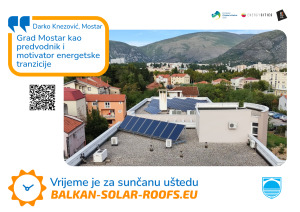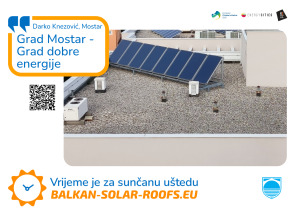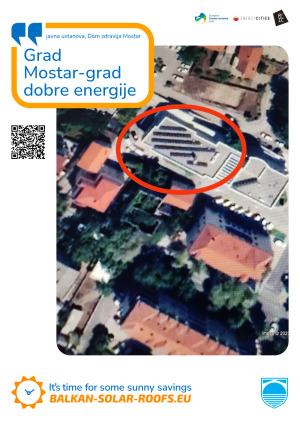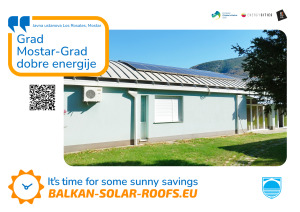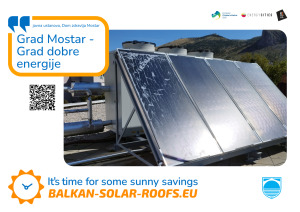Mostar uses energy from the Sun
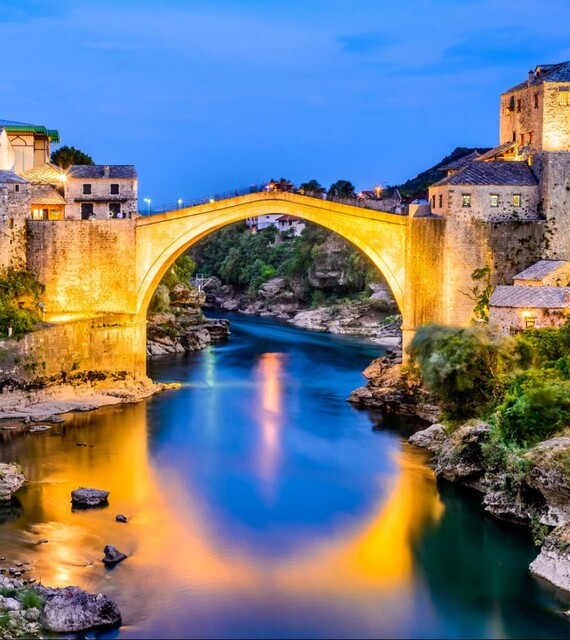
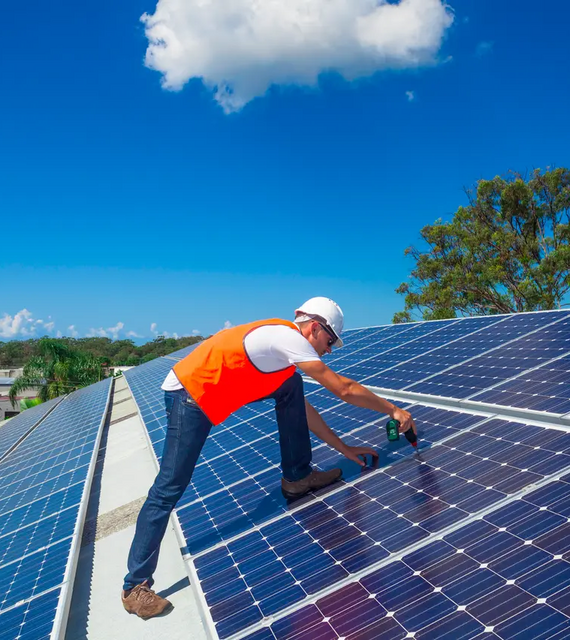
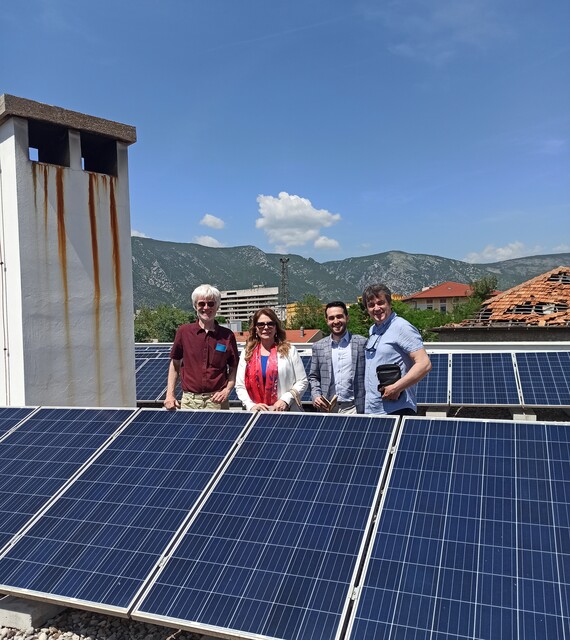
Mostar
Location
The city of Mostar is an administrative unit of local self-government within the Herzegovina-Neretva County, and thus the Federation of Bosnia and Herzegovina. It is located in the south of Bosnia and Herzegovina. In the north it borders the municipalities of Jablanica and Konjic, in the east with the municipalities of East Mostar and Nevesinje (Republika Srpska), in the south with the municipality of Stolac and the City of Čapljina, and in the west with the municipality of Čitluk, the City of Široki Brijeg and the municipality of Posušje (West Herzegovina County). The city area consists of mountainous and lowland parts. The mountainous part of the city area is concentrated in the north. The Čvrsnica mountain stretches from the Blidinje Nature Park and the border with the Posušje and Jablanica municipalities. In the northeast of the city area, along the border with the municipality of Konjic, lies the mountain Prenj.
To the east of the city area there is the mountain Velež, while to the west of the city area, along the border with the municipality of Posušje and the town of Široki Brijeg, there is mountain Čvrsnica. In the center of the city area is the city of Mostar with its three basins, while the southern, southeastern and southwestern parts of the city area are covered with hills up to 500 m high, which form a kind of plateau, with the exception of Mostarsko blato in the extreme west. The highest point of the city is on the mountain Prenj 2115 m (Zelena glava), and the lowest point in the extreme south in the suburban settlement Žitomislići at 20 m.
Mostar is located 132 km southwest of Sarajevo and 57 km northeast of Ploče, in the transitional area from the low Herzegovina karst to the mountainous area of high Herzegovina. It extends into three basins. In the north there is Bijelo Polje, where most of the northern suburbs are located. In the center is the Mostar basin, where the city of Mostar and most of the western suburbs are located, and to the south lies Bišće Polje (Mostarsko polje), where most of the southern suburbs and the industrial zone are located.
The city of Mostar, based on its geostrategic position, has been an important traffic center since the Middle Ages. Today, three forms of transport stand out on the territory of the city: road, rail and air. A very important traffic route passes through the city area, the main road M17, which is part of the European corridor E73 and the railway line Sarajevo - Ploče. The city of Mostar also has an international airport, which is located in the suburban settlement of Ortiješ and which is an important factor in the economic development of the city.
Soon, the highway on corridor Vc will pass through the City of Mostar, which will put Mostar on the European highway network and thus increase economic progress even more.
Climate
Due to its specific location, the city of Mostar has a moderate Mediterranean climate with mild but cold winters (with little or no snow) and in hot summers temperatures in the shade can often reach 45°C. Mostar, along with the main city of Greece, Athens, is the warmest city in Europe and the city with the sunniest days in one year. The average number of hours of sunshine in the area of the city of Mostar for the period 1992-2020 is 2437.4 hours. For the same period, the average amount of precipitation is 1444.8 mm. Considering the mild climate, the area of the city of Mostar is extremely favourable for growing various agricultural crops, especially Mediterranean ones such as vines, olives, tomatoes, etc.
Solar energy – As one of the cities with the highest number of hours of sunshine in Bosnia and Herzegovina, Mostar has a huge potential for the production of electricity and the preparation of domestic hot water from this source. Control over energy and its use are today one of the main prerequisites for general development and even survival. From the entire history of energy use, it can be seen that the increase in living standards has always been associated with increased energy use. Our human race first began to cautiously use renewable energy sources, but then gradually switched to reckless use of non-renewable energy sources, which has the consequence of creating undesirable climate changes on Earth.
Our modern way of life and technological development contribute to an increase in the amount of greenhouse gases in the atmosphere. In recent decades, the greenhouse effect has been in the center of attention of the world public. We realize that the current model of development is not sustainable. Humanity is facing its greatest challenge, the transition of society towards sustainability. Today, interest in the use of various types of renewable energy sources, both internationally and locally, is growing significantly precisely because of the more difficult reduction of human influence on the creation of the greenhouse effect. Aware of these facts, we should improve our way of life so that we do not endanger the needs of future generations. Through its actions on planet Earth, humanity is literally balancing on a tightrope in terms of maintaining natural conditions suitable for life.
The city of Mostar has made a responsible commitment to energy-sustainable development of the city based on the principles of energy efficiency, sustainable construction and the use of renewable energy sources.
Encouraging citizens to step out of the role of passive buyers and consumers of energy that someone else produces and puts on the market, and to become active buyers, consumers, i.e. prosumers, who produce, consume and sell their own energy, is a key step towards changing the way we supply energy to our homes, their communities, their settlements and cities.
Solar energy is a form of energy that is practically unused and more environmentally friendly. According to the FBiH Action Plan for the use of RES, the construction of micro solar power plants is desirable, which enables the placement of produced electricity consumption in the immediate vicinity, which to a certain extent contributes to the development of the economy and local community, as well as the development of rural and isolated areas. In the process of building solar power plants, production and installation of equipment, engineering and other services of domestic components are especially desirable and possible. Using solar energy for heating and preparing hot water achieves a significant effect of saving other forms of energy and energy sources, as well as increasing energy efficiency. Solar energy can be used for: - heating needs for hot water consumption, - heating buildings based on the principles of solar architecture (passive use), - heating water for space heating and - electricity production.
The annual inflow of solar energy per 1 m2 of horizontal surface in the area of Mostar is about 1,600 kWh, and the number of sunny hours is about 2,200 per year. In the case of a surface placed at an optimal angle (without tracking the sun), solar insolation is higher by at least 20% on an annual basis. Taking into account the area of Mostar of 1,175 km2 and the average inflow of solar energy on the optimally placed area of 2,000 kWh/m2, the total natural energy potential of the Sun in Mostar amounts to 2,350 TWh, which is more than 2,000 times more than the total energy needs.
This shows that the use of solar energy is not a matter of potential, but of an energy policy that will direct the use of solar energy in the function of local sustainable development. Decentralized production and use of local renewable energy sources, which is the basis of the energy transition, also leads to improved security of energy supply, greater resistance to crisis situations, opens up the possibility of greater control over the overall price of energy, and ultimately enables the active involvement of citizens in production and sales of energy, whereby citizens cease to be only passive buyers and consumers become active buyers (eng. PROSUMER), that is, producers and active participants in the energy market and in the energy transition.
Electricity consumption in Mostar in 2014 was about 2,422 kWh/per cent. With a photovoltaic power plant efficiency of about 17%, it would be necessary to install about 7.12 m2 per inhabitant to cover the electricity needs.
Resources
- BSR Charter_Bosanski [ba]
- SolarCET: Online info radionica [ba]
- Poziv za info radionicu - projekt SolarCET [ba]
- Info radionica za projekt ugradnje solarnih sistema privukla veliki broj građana Mostara [ba]
- Gradonačelnik Kordić zahvalio premijeru Hercegu na potpori u realizaciji važnih projekata [ba]
- Smjernica za smanjenje potrošnje energije i energenata u Federaciji BiH [ba]
- Mostar i Karsiyaka partneri u projektu energetske učinkovitosti obnove javnih objekata [ba]
- Predstavnici Grada Mostara na energetskom summitu u Neumu [ba]
- Grad Mostar potpisao Memorandum razumijevanja o priključenju EBRD Zelenim gradovima [ba]
- Predstavljena modernizacija sustava javne rasvjete Grada Mostara [ba]
- Imamo dosta zainteresiranih za nove investicije u Mostaru [ba]
- IMPULSE Interreg MED Grad Mostar [ba]
- IMPULSE Interreg MED Grad Mostar Video 2 [ba]
- Grad Mostar, DEI video o IMPULSE Mostar [ba]
- Euroimpuls [ba]
- ImpulseOnline.eu [ba]
- Solarni paneli [ba]
- #StrujuNaSunce [ba]
- UNDP Bosnia and Herzegovina [ba]
- #solarcet [ba]
- Mostar Balkan Solar Roofs promotion video [ba]
- FBiH policy recommendations
- Zaključci i preporuke info radionica_FBiH [ba]
- POSTANI PROIZVOĐAČ-POTROŠAČ ENERGIJE! [ba]
- KAKO PODSTAĆI PROMJENE [ba]
- Video Balkan Solar Roofs City of Mostar 2 [ba]
Interesting facts
- Average insolation
- 6.5 hours/day
- Renewable energy generated
- 1 GWh
- CO2 savings so far
- 0.587 kT CO2
- Financial savings so far
- € 91969
- Roof equivalents
- Private: 74 | Public: 27
- Technology
- Photovoltaic: 96 | Thermal: 5
Gallery
